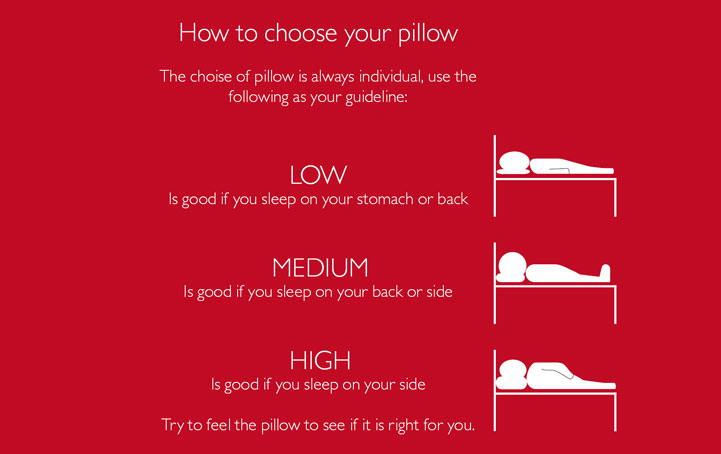Some people use the same type of pillow almost all their lives, while others change pillows as their needs change over time. New sleeping habits, neck pains or other changes in life can greatly affect your choice of pillow. See our large selection of different pillows right here.
When choosing a new pillow, it is a good idea to talk to a specialist at your Ringsted Dun retailer. First, however, you can benefit from preparing from home using the questions below and the guide to choosing a pillow.
How often should I change my pillow?
Pillows need to be washed and replaced more often than duvets, as they are used more and are more exposed to sweat, etc. Our advice is that you change your pillow approximately every two years. That way you will always have a fresh, clean, supportive and comfortable pillow to rest your head on.
How to choose your new pillow
How do you sleep -and what pillow should you choose?
Read more below about which pillow height suits you.

Low pillow
If you often sleep on your back or front, you can choose an extra-low or low pillow. It depends on what you are used to and prefer. The shift between the mattress and the neck will not be great, so it doesn’t take much to support your spine. If the pillow being soft and flexible is more important to you than support and lift, choose a pillow which contains more down than small feathers.
Medium pillow
If you often sleep on your back or side, you can choose a medium-height pillow. The exact type of pillow that is right for you depends on the softness of the mattress, the way you lie, your shoulder width and the curvature of your back. If supports and lift is more important to you than the pillow being soft and flexible, your pillow should contain more small feathers than down. Of course, small feathers are not quite as soft as down, but a pillow containing mainly feathers keeps its shape better throughout the night – here, a 3-chamber pillow really comes into its own.
High pillow
If you often sleep on your side, you can choose a high or extra-high pillow – what is best for you depends on your sleeping position and what you are used to. A high pillow supports and lifts both your head and neck – a 3-chamber one is an optimal choice.
The difference between 1-chamber pillows, 3-chamber pillows and 4-chamber pillows
1-chamber pillow
This type of pillow has a single sort of filling throughout. The filling can be soft down, but is often a mixture of small feathers and down, which provides a bit more support than pure down. This type of pillow is soft and easy to shape, so you lie comfortably and flat.
3-chamber pillow
3-chamber pillows are filled with small, supportive feathers and down and in their core, while the outer layers are filled with lovely, soft down, making the pillow soft. This type of pillow keeps its shape during the night and provides optimal support for the head and neck.
4-chamber pillow
A 4-chamber pillow has small, supportive feathers and down in the two outer chambers, while the two middle chambers contain lots of soft down. This combination provides good support for the neck, as the head is allowed to sink slightly into the soft down in the middle.

What to look for?
The type of fabric
Our pillow fabrics come in different types, but always have a focus on quality, no matter what you choose. You can choose between our cotton cambric, cotton satin and cotton batiste for your pillow fabric. The finer the thread, the higher the quality. Cotton batiste is the finest quality.
Read more

Labels
Find your way around the label jungle. What labels and certifications should be on your new duvet? See i.a. according to whether the duvet is marked with STANDARD 100 by OEKO-TEX® Class I, NOMITE and Downafresh® greenline. And last but not least: Check if the duvet is produced in Denmark.
Read moreWhy choose duvets and pillows with natural filling?


